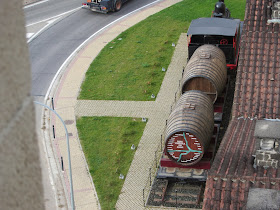Colheita (pronounced coal-yate-a) is a vintage-dated Tawny which has been aged for 7 years prior to bottling. The extended wood and oxygen contact yields: (i) pruney-raisiney and toasted-wood aromas; (ii) honey, caramel, and toasted-nut flavors; (iii) a certain delicacy as a result of the mellowing out of the tannic structure; and (iv) a concentration in the wine. Kopke produces an average of 1 million bottles of Colheita per year aimed primarily at the Portuguese and broader European markets. The label on this wine will generally show both the harvest and bottling dates.
The meeting was called to order by by Dayona Moreira, the Marketing Manager for Sogevinus Fine Wines. She introduced her colleague as Carlos Alves, the Kopke Winemaker, and, after a few opening statements, she passed the baton over to him.
Carlos indicated that we would be tasting the the wines in order from youngest to oldest in order to ensure that the flavors of the younger wines would not be "hidden" by the older wines. All of the wines to be tasted were blends of equal parts Touriga Nacianal, Tinta Roriz, Touriga Franca, and Tinta Barroca. All were at 20% alcohol levels.
Kopke Porto Colheita Tawny 1983: This wine had a deep brick color and aromas that were decidedly dried fruits, milk caramel, honey, vanilla, and figs. These were buttressed by subtle hints of molasses and El Dorado Rum. On the palate dried fruits, caramel, and toffee, complementing a deliciously creamy, silky texture and over-arching freshness. A long, slightly bitter, finish.
Kopke Porto Colheita Tawny 1974: Elegant nose. Dried fruits, vanilla, chocolate, and coffee. Velvety on the palate with good acidity, structure, and finesse. Persistence on the finish.
Kopke Porto Colheita Tawny 1966: Brown in the glass, richness on the nose. Aromas of dried fruits, mocha, cinnamon, and vanilla. Plum, dried figs, coffee, toffee, and vanilla on the palate. Silky, delicate, and elegant. Fresh. Balanced.
Kopke Porto Colheita Tawny 1983: Amber color. Complex aromas of vanilla, chocolate, almonds, orange, and honey. Delicate on the palate. Persistent, elegant, and fresh. Richness along with a hint of spiciness.
Kopke 375 Special Edition Porto Colheita 1940: This wine was produced during WWII and had been resting for 73 years in a 580-liter oak barrel numbered 10053. The number 375 indicates the number of years the company has been in business as well as the number of bottles made for the special edition issue.
This wine was deserving of its packaging. It demonstrated that age is this wine's best friend. Petrol on the nose. The fruit is drier and less apparent allowing brighter freshness and more complexity to shine through. Dried fruits and walnuts. Long, delicate, harmonious finish.
From my perspective, this was an excellent beginning to the conference. I attempted to purchase the 375 on display but Dayona would have none of it. Each attendee received a small sample bottle of the 375 to take home. That was a nice gesture. I would recommend this wine. As I stated previously, I feel that the older the vintage of this wine you drink, the more appreciative of this wine you will be.
©Wine -- Mise en abyme


















































.jpg)
.jpg)